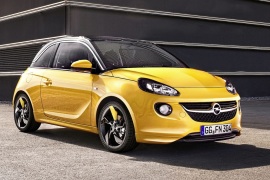OPEL Adam Models/Series Timeline, Specifications & Photos
First production year: 2013
Engines: Gasoline
Body style: Hatchback
Opel tried to enter into the supermini segment and created the Adam, which it launched at the 2012 Paris Motor Show for the 2013 model year.
In Europe, the supermini segment was dominated by French and Italian cars, closely followed by Ford and Volkswagen. GM tried to get a slice of the pie and used the same platform from the Corsa lineup to create the Adam. The new vehicle was named after Opel’s brand founder, Adam Opel. GM hoped the new car would sell in high numbers and help the European brand stay afloat after the world financial crisis that emptied the pockets of the American company. Unfortunately, sales weren’t confirmed, and during its seven-year production, only a little over 300,000 units found an owner. Its main competitors were the Fiat 500, the Renault Twingo, and the Peugeot 108, which did better on the market than the Adam. However, Opel tried a different approach, offering the car an extensive customization program that led to over 30,000 variations depending on grades, color combinations, cabins, and drivetrains. But still, that wasn’t enough to save the struggling German brand, which ended up being sold in 2017 to Peugeot-Citroen.
At the front, the little car showed a smiling grille where the brand’s logo took center stage, supported by a pair of horizontal slats. A pair of fog lamps flanked it, while lower, on the apron, the automaker added a black, A-shaped air intake. The up-mounted headlights were swept back towards the A-pillars, being protected against shopping carts and small bumps in parking lots. Furthermore, these featured LED daytime running lights, a first in the European A-segment.
From its profile, the short hood was followed by a steep panoramic windshield. Customers could get the Adam with contrasting roof and door mirrors as an option. The base version was provided with steel wheels, while the upper grades got alloy ones. Unusually, the car was available with up to 18-inch alloy wheels. On the door panels, Opel created a sculptured area that echoed the one introduced on its flagship model, the Insignia. Another unique feature of a supermini vehicle from those times was the floating roof design, emphasized by chromed trims on the C-pillars. Finally, at the back, the leaf-like LED taillights were installed above the bumper, on the corners, flanking the small tailgate that was adorned by a roof spoiler on its upper side.
Inside, at the front, there was loads of room for adult-sized occupants on the ergonomically designed seats. These were separated by a center console that housed the gear stick and the handbrake. Opel installed the controls for the HVAC system on the center stack. As an option, customers could get the vehicle with a touchscreen for the infotainment system named IntelliLink, which could be paired with Apple iOS and Android smartphones. Fronting the driver was a binnacle instrument cluster that housed two large dials for the speedometer and the rev counter, which in turn integrated the fuel level and the coolant temperature, respectively. In the back, there was hardly room for adults, although it proved to be spacious enough for children.
Under the hood, Opel installed a choice of three engines, all fueled by gasoline, that sent their power to the front wheels via either a five or a six-speed manual.
